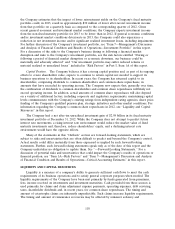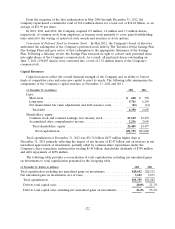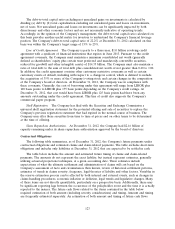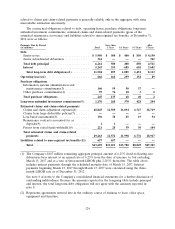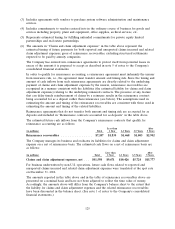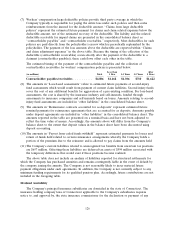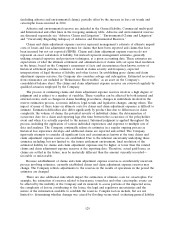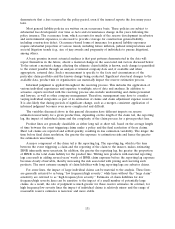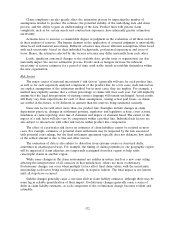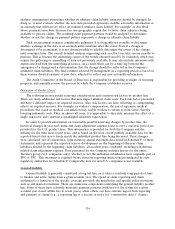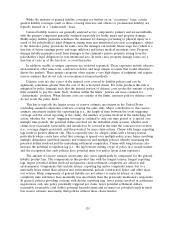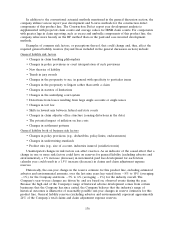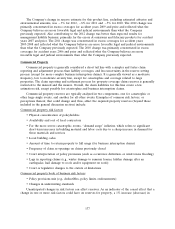Travelers 2012 Annual Report Download - page 139
Download and view the complete annual report
Please find page 139 of the 2012 Travelers annual report below. You can navigate through the pages in the report by either clicking on the pages listed below, or by using the keyword search tool below to find specific information within the annual report.dividend that, together with other distributions made within the preceding twelve months, exceeds the
greater of 10% of the insurer’s capital and surplus as of the preceding December 31, or the insurer’s
net income for the twelve-month period ending the preceding December 31, in each case determined in
accordance with statutory accounting practices and by state regulation. This declaration or payment is
further limited by adjusted unassigned surplus, as determined in accordance with statutory accounting
practices. The insurance holding company laws of other states in which the Company’s subsidiaries are
domiciled generally contain similar, although in some instances somewhat more restrictive, limitations
on the payment of dividends. A maximum of $2.05 billion is available by the end of 2013 for such
dividends without prior approval of the Connecticut Insurance Department. The Company may choose
to accelerate the timing within 2013 and/or increase the amount of dividends from its insurance
subsidiaries in 2013, which could result in certain dividends being subject to approval by the
Connecticut Insurance Department.
The holding company is not dependent on dividends or other forms of repatriation from its foreign
operations to support its liquidity needs. The undistributed earnings of the Company’s foreign
operations are not material and are intended to be permanently reinvested in those operations.
The holding company received $1.96 billion of dividends in 2012, all of which was received from its
U.S. insurance subsidiaries.
Pension and Other Postretirement Benefit Plans
The Company sponsors a qualified non-contributory defined benefit pension plan (the Qualified
Plan), which covers substantially all U.S. domestic employees and provides benefits primarily under a
cash balance formula. In addition, the Company sponsors: a nonqualified defined benefit pension plan
which covers certain highly-compensated employees, pension plans for employees of its foreign
subsidiaries, and a postretirement health and life insurance benefit plan for employees satisfying certain
age and service requirements and for certain retirees.
The Qualified Plan is subject to regulations under the Employee Retirement Income Act of 1974
as amended (ERISA), which requires plans to meet minimum standards of funding and requires such
plans to subscribe to plan termination insurance through the Pension Benefit Guaranty Corporation
(PBGC). The Company does not have a minimum funding requirement for the Qualified Plan for 2013
and does not anticipate having a minimum funding requirement in 2014. The Company has significant
discretion in making contributions above those necessary to satisfy the minimum funding requirements.
The Company made discretionary contributions to the Qualified Plan of $217 million, $185 million, and
$35 million in 2012, 2011 and 2010, respectively. In determining future contributions, the Company will
consider the performance of the plan’s investment portfolio, the effects of interest rates on the
projected benefit obligation of the plan and the Company’s other capital requirements. The Company
has not determined whether or not additional discretionary funding will be made in the current year or
beyond. However, the Company currently believes, subject to actual plan performance and funded
status at the time, that it may make discretionary pension contributions of approximately $75 million to
$100 million annually over the next few years.
The Qualified Plan assets are managed to maximize long-term total return. The Company’s overall
strategy is to achieve a mix of approximately 85% to 90% of investments for long-term growth and
10% to 15% for near-term benefit payments with a wide diversification of asset types, fund strategies
and fund managers. The current target allocations for plan assets are 55% to 65% equity securities and
20% to 40% fixed income securities, with the remainder allocated to short-term securities. For 2013,
the Company plans to apply an expected long-term rate of return on plan assets of 7.50%, the same
rate as in 2012. The rates of return reflect the Company’s current expectations of long-term returns on
the plan’s invested assets, taking into account the current low level of long-term interest rates as well as
the Federal Reserve’s commentary in January 2013 regarding its expectation to maintain interest rates
at their current low levels until the national unemployment rate drops to 6.5%. The Company’s
expected long-term rate of return on plan assets also contemplates a return to more normal levels of
long-term interest rates in the future.
127



